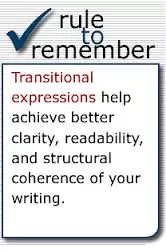 Common Transition Words and Phrases
Common Transition Words and Phrases

✅ AI Essay Writer ✅ AI Detector ✅ Plagchecker ✅ Paraphraser
✅ Summarizer ✅ Citation Generator
The information presented in any academic paper must be structured and well-organized in order to convey its meaning clearly. To make readers’ attention flow from one idea to another smoothly, and to make the paper readable by connecting its semantic parts and indicating their relationships, transition words and phrases are used.
The material you describe can be divided into two parts: facts which you introduce, and the relationships you construct between them. Transitions prepare readers for understanding upcoming information by alerting them as to how they should react to presented ideas, and how to piece them together into a logically-coherent argument. In other words, transitions are meant to make the organization of your paper easier to follow.
There are a variety of transitions, and this guide observes those that are used most commonly.
Types of Transitions
Transitions can be divided into several categories: Addition, Compare and Contrast, Time, Cause and Effect, Summary and Conclusion, and Example.
Addition transitions are needed to indicate another piece of information is going to be introduced in addition to what has been presented already. New information doesn’t need to be in a causative, time, or other relationship to what has been written so far.
Compare and Contrast transitions are used to make it clear for the reader how two or more items are going to be analyzed in relation to each other, or how characteristics of one item that another one doesn’t possess are going to be introduced.
Time transitions usually serve to show how events are related to each other in terms of time; these transition words help readers follow the sequence of events and structure them in the order in which they occurred.
Cause and Effect transitions show how certain circumstances or events were caused by other factors. They make it easier for the reader to follow the logic of the arguments and clauses represented in paper.
Summary and Conclusion transition words indicate the author of the paper has listed all of their arguments on a respective issue, and is summarizing the information in a brief manner.
Example transitions notify the reader how the upcoming information will serve as an illustration or explanation of the described material.
Most Common Transitions
Addition:
furthermore, in addition, besides, also, even more, moreover, again, as well, equally important, together with, along with
Compare and Contrast:
comparable to, just as, in the same manner, as if, in comparison, likewise, accordingly, although, as opposed to, however, even though, on the contrary, on the other hand, otherwise
Time:
in the meantime, meanwhile, until, when, next, immediately, before, after, afterward, as soon as, subsequently, following
Cause and Effect:
because, because of, caused by, respectively, as a result, for this reason, consequently, therefore, thus, this is why, due to
Summary and Conclusion:
as a result, in accordance with the aforementioned facts, ultimately, in view of the factors mentioned
Example:
for instance, for example, to illustrate, as it can be seen by, in other words, namely, specifically, according to
Follow us on Reddit for more insights and updates.


Comments (0)
Welcome to A*Help comments!
We’re all about debate and discussion at A*Help.
We value the diverse opinions of users, so you may find points of view that you don’t agree with. And that’s cool. However, there are certain things we’re not OK with: attempts to manipulate our data in any way, for example, or the posting of discriminative, offensive, hateful, or disparaging material.